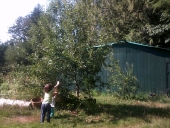




Mobile Chicken house build-
http://www.permies.com/t/48452/chickens/Mobile-Chicken-house#388147








Mobile Chicken house build-
http://www.permies.com/t/48452/chickens/Mobile-Chicken-house#388147




“Enough is as good as a feast"
-Mary Poppins




Mobile Chicken house build-
http://www.permies.com/t/48452/chickens/Mobile-Chicken-house#388147






 1
1





“Enough is as good as a feast"
-Mary Poppins

 1
1




Owner, Etta Place Cider




Ann Torrence wrote:Go to the library and check out either of Michael Phillips books on orcharding. I use both. The Holistic Orchard is a great resource for natural methods to control predators and maintain healthy trees.
June drop is normal for apples-they set more fruit than the tree can support. The drops need to be cleaned up to break certain pest lifecycles. With a rake if it's one tree, animals can do the job in a larger system. Phillips covers this in his book.
Check out Hoar Frost Farm on Facebook

 2
2




List of Bryant RedHawk's Epic Soil Series Threads We love visitors, that's why we live in a secluded cabin deep in the woods. "Buzzard's Roost (Asnikiye Heca) Farm." Promoting permaculture to save our planet.




Marianne
check us out @ www.cricketscove.net




Willy Walker wrote:
One thing I heard in a podcast was about the cow manure and clay mix to wrap around the trunk of the trees. That is also in my back pocket. 😎
Marianne
check us out @ www.cricketscove.net

|
Yes, my master! Here is the tiny ad you asked for:
Freaky Cheap Heat - 2 hour movie - HD streaming
https://permies.com/wiki/238453/Freaky-Cheap-Heat-hour-movie
|


